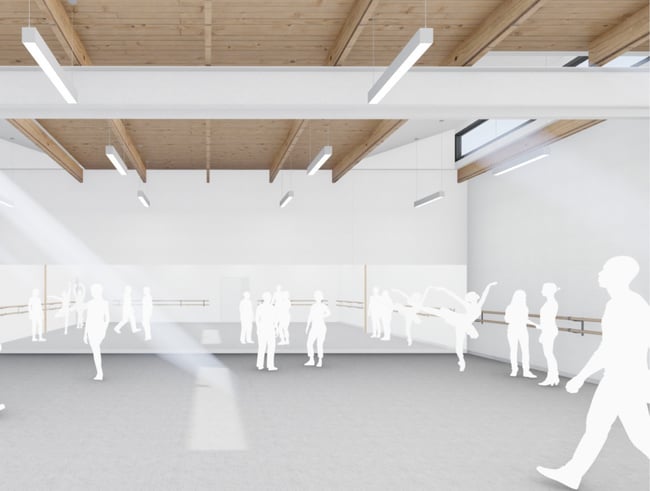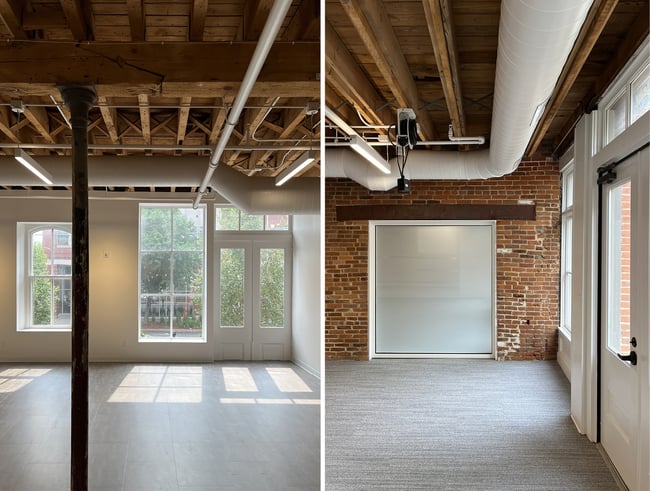Promoting the Arts: Iowa Conservatory to Open in August 2023

In August 2023, the Iowa Conservatory will open its doors to students. The performing arts school, located in Iowa City’s Northside neighborhood, will offer unique educational paths for high-school students to expand their creative interests.
Full- and part-time students will be able to take classes in dance, theater, music, and visual art—taught by talented faculty recruited from across the country. The school is the first of its kind in Iowa and one of the few in the Midwest.
At Neumann Monson, we are proud to be a part of this groundbreaking project. This article will discuss its background, design process, and the spaces and features students can expect in the completed building.
Project Background: Bringing Performing Arts Education to Iowa
Leslie Nolte and Beth Brown began working together in 2012 after opening the Performing Arts Preschool, an early childhood program focused on the arts in Coralville, IA.
Brown has been designing educational programming for over 30 years. Her impressive career includes writing curriculum and teaching music at Iowa City Community Schools, directing the Iowa City Youth Choir and Nolte Nutcracker Chorus, and teaching at the University of Iowa’s College of Education.
Nolte has long been a champion of the performing arts in the Iowa City area. She is the founder of the James Theatre and Nolte Academy, a premier dance studio with more than 1000 students.
After founding the Performing Arts Preschool, Nolte and Brown began envisioning a program for high school students. More than 35,000 students attend performing arts schools in the US—most on the East and West Coasts.
Outside of two schools in Michigan and Minnesota, the Midwest offers few opportunities for students wanting to focus on the arts. Nolte and Brown wanted to create a regional hub for nurturing young talent, and with its long history of supporting the arts, Iowa City was the ideal fit.
Educational Offerings
The Iowa Conservatory will offer three educational paths. Full-time students will receive 25+ hours of instruction while earning a high school diploma through Iowa City Community School District’s online program.
Part-time commuter students will attend the Conservatory in the afternoon after a traditional school day. The Conservatory will also offer a gap year program for students wanting to hone their artistic interests before taking the next step in their post-secondary education.
To attract students from around the country, the Iowa Conservatory will offer a boarding option, with residential counselors to help students adjust to life away from home.
Design Process: Finding the Ideal Site
Nearly four years ago, Nolte approached Neumann Monson about the project. Initially, the design team envisioned a purpose-built facility and explored several site options.
As the project progressed, rehabilitating a building in downtown Iowa City felt more in line with the project’s goals. A 19th-century building in Iowa City’s Brewery Square was the ideal fit.
As the name suggests, the building was used for beer production originally. Over the years, it has housed many tenants, including an advertising company and a cosmetology school. Locating the school in the Northside was an opportunity to enliven this neighborhood with a new demographic.
Unlike many educational settings, the building houses a mix of tenants. A restaurant anchors one side of the building, and the upper floors contain office space. The challenge was to create a secure environment for students while remaining sympathetic to other tenants.
Spaces and Features: Highlighting Historic Character
The building is programmed to fit the variety of courses offered at the Iowa Conservatory. Its north side, sitting below upstairs tenants, contains more traditional classrooms for visual arts and theater courses.
The south side is a single-story building containing noisier dance and music rooms, with acoustic wall separation. All rooms were outfitted with Audio/Visual equipment for educational purposes.

Dance rooms on the building's south side.
The goal was to create a space that encouraged creativity. To do so, we took a “white box” approach where colors and personality are added by the user rather than the architecture.
Walls are kept simplistic and white, with occasional graphic elements in the corridors to highlight different programs and assist with wayfinding. Mechanical systems and light fixtures are also painted white.
The building contains many historic details, including red brick masonry and exposed wood structure. This white box approach helps highlight and celebrate these features.

Corn-blasted ceilings and exposed masonry.
Ceilings were corn-blasted to bring out their warmth and masonry was kept exposed. Existing openings in the masonry walls were filled with translucent glazing, allowing daylight to travel deeper into the building’s core. The result is a light and airy space, grounded by the warmth of historic character.
Learn About Other Building Projects in Iowa
The Iowa Conservatory is a truly novel approach to secondary education in Iowa. When complete, it will attract a new demographic to the state, diversify the Northside neighborhood, and strengthen Iowa City’s reputation for being “the best small city for the arts.”
The building’s design—decidedly sympathetic to its history—will provide a blank canvas for students to learn, dream, and create.
The Iowa Conservatory is one of many exciting building projects in Iowa. Across the state, forward-thinking organizations are embarking on projects to strengthen their communities.
In Des Moines, Marquas Ashworth—a local entrepreneur and rap artist—is working to create an incubator space for Black- and brown-owned businesses. Learn more by reading about the project’s background.